Project optimisation: Realising returns


Lee Downham leads EY’s global transactions advisory business for mining and metals
In recent years, the financing environment for mining and metals companies of all sizes has been particularly tough, which has, in turn, put greater pressure on capital allocation decisions. Dramatic volatility and uncertainty in metal prices, energy costs, interest rates and foreign exchange rates continue to drive these twin capital dilemmas, with a subdued risk appetite across the sector creating investment barriers.
In the absence of traditional investor interest, many companies have broadened the scope of investment decisions to encompass ‘buy, build and return’ options, with divestments increasingly on the agenda. And although nearly half of executives in the sector believe credit availability is improving – according to EY’s latest ‘Capital Confidence Barometer: Mining and Metals’ – companies are looking more closely at their asset portfolios to rationalise investment and prioritise growth. Management teams across the industry are reviewing noncompetitive assets and refocusing on strategic projects. This type of portfolio analysis and management is crucial to capital efficiency in today’s cash-strapped mining and metals sector.
Research shows that companies with high levels of capital reallocation experience higher average shareholder returns, yet the discipline of critically reviewing portfolios is seldom ingrained in yearly planning processes. Too often companies lose sight of portfolio optimisation and fall victim to poor portfolio management. Bad habits can include one dimensional project evaluation – where companies fail to weigh all the dynamics involved in a project. Companies can also base business cases for investments on a “preferred approach” that may be influenced by bias within a commodity group or to a project with emotional attachment. And lastly, perhaps one of the biggest pitfalls companies face is using inadequate performance measures focused too heavily on traditional finance measures and not fully aligned with companies’ strategic direction.
Some of the key symptoms of portfolio inertia that negatively impact business performance include:
• Not adequately managing portfolio sensitivity to business cycles.
• Failing to fully attribute value to optionality within projects.
• Too circumscribed a view and failing to compare ‘on the table’ options with alternative uses of capital.
• A lack of understanding of the interdependency of risk across projects and how a change in value to an asset may not directly translate to the same change in value of the portfolio.
Companies must meet these challenges head-on to realise better results. Seizing opportunities requires companies to take a hard look at their assets and project pipeline. Portfolio optimisation should not be a short-term strategy either. It is a best practice that companies of all sizes should work into their organisations. Robust portfolio management not only identifies assets that become off strategy, it also contributes to the long-term health of an organisation. The advantages this holds include:
• Establishing a framework and an orderly set of priorities for investment.
• Managing risk by striking a balance between cash generating and cash using businesses.
• Facilitating a management control system that balances the current and future strategic direction of the portfolio.
• Providing greater support for management to share portfolio investment decisions with external stakeholders.
Today’s miners face tough capital decisions where one wrong turn could damage growth prospects or destroy shareholder value over the longer term. Executives must place more emphasis on understanding the benefits and risks of capital allocation decisions. Rigorous portfolio management and greater scrutiny around investment selection, prioritisation and management is vital. Those that undertake a disciplined and holistic approach will be best positioned for success.
• Lee Downham leads EY’s global transactions advisory business for mining and metals. He is based in London.
Comments
Press Office
Announcements
What's On
Subscribe to improve your user experience...
Option 1 (equivalent of R125 a month):
Receive a weekly copy of Creamer Media's Engineering News & Mining Weekly magazine
(print copy for those in South Africa and e-magazine for those outside of South Africa)
Receive daily email newsletters
Access to full search results
Access archive of magazine back copies
Access to Projects in Progress
Access to ONE Research Report of your choice in PDF format
Option 2 (equivalent of R375 a month):
All benefits from Option 1
PLUS
Access to Creamer Media's Research Channel Africa for ALL Research Reports, in PDF format, on various industrial and mining sectors
including Electricity; Water; Energy Transition; Hydrogen; Roads, Rail and Ports; Coal; Gold; Platinum; Battery Metals; etc.
Already a subscriber?
Forgotten your password?
Receive weekly copy of Creamer Media's Engineering News & Mining Weekly magazine (print copy for those in South Africa and e-magazine for those outside of South Africa)
➕
Recieve daily email newsletters
➕
Access to full search results
➕
Access archive of magazine back copies
➕
Access to Projects in Progress
➕
Access to ONE Research Report of your choice in PDF format
RESEARCH CHANNEL AFRICA
R4500 (equivalent of R375 a month)
SUBSCRIBEAll benefits from Option 1
➕
Access to Creamer Media's Research Channel Africa for ALL Research Reports on various industrial and mining sectors, in PDF format, including on:
Electricity
➕
Water
➕
Energy Transition
➕
Hydrogen
➕
Roads, Rail and Ports
➕
Coal
➕
Gold
➕
Platinum
➕
Battery Metals
➕
etc.
Receive all benefits from Option 1 or Option 2 delivered to numerous people at your company
➕
Multiple User names and Passwords for simultaneous log-ins
➕
Intranet integration access to all in your organisation



















